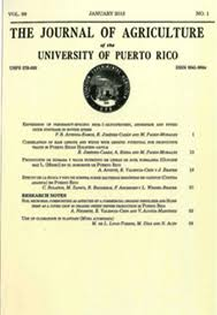Abstract
We compared the effect of the period of days on feed (DOF) to reach the slaughter weight on performance, hot and cold carcass yield, and wholesale
(primal) and retail cuts of native lambs fed in confinement with total rations
(TR). Meat quality including fatty acid profile was also determined. The TR containing 70% concentrate and 30% tropical grass hay was offered
at 4.5% of the live weight of the lamb on a dry matter basis until the preestablished
slaughter weight of 20 to 25 kg (SW1) or 46 to 50 kg (SW2) was achieved. Three feeding pens with four ‘five- to seven-month-old’ lambs were used as experimental units during the DOF period to reach SW1,
and two animals per pen were used during the DOF period to reach SW2. During each DOF period, voluntary dry matter intake as a percentage of
animal weight (DMI) per pen was quantified. To determine the daily weight gain (ADG) per animal and the feed conversion (FC) per pen, the lambs were weighed weekly. When SW1 and SW2 were achieved, six lambs per
weight were slaughtered in a commercial abattoir to determine hot (HCY) and cold (CCY) carcass yield. The wholesale (primal) cuts evaluated were neck (N), shoulder (SL), ribs 6-13 (RIB), loin (LN) and leg (LG); and retail cuts (RTC) included shoulder chop (SCH), French chop (FCH), ribs (RS), back leg (BL), shanks (SH), and stew meat (ST). Samples of Longissimus dorsi were obtained from each carcass to determine meat quality as
evidenced by pH, tenderness, color, nutrient content, and fatty acid profile in the muscle. The data were analyzed using a completely randomized
design with two treatments (DOF) and three repetitions (pen) for DMI and FC and six repetitions (animal) for the other variables evaluated. The
DOF of native lambs fed with TR to reach SW 1 and SW2 were 42 and 128, respectively. The DMI of the dry matter per pen in relation to the live weight of the animals and the ADG per lamb were similar (P=0.05) for both DOF
periods, but FC was lower (P<0.05) in lambs at SW1 than SW2. The HCY and CCY were greater (P<0.05) in lambs slaughtered at SW2 than SW1. Yield from primal cuts SL, LN, and LG and retail cuts SCH, RS, SH, and BL were also higher in lambs at SW2 than those slaughtered at SW1. Meat quality, color, and tenderness criteria were similar (P=0.05) for both slaughter weights. Crude protein was higher (P<0.05) in lambs slaughtered at SW1 than at SW2, but crude fat and total lipid content were lower. The content of
polyunsaturated fatty acids (PUFA) n-3 and n-6 content was higher (P<0.05) in lambs at SW1 than SW2, but the PUFA n-6/n-3 ratio was lower (P<0.05). Differences in individual fatty acid content due to DOF period and slaughter weight were also observed. In conclusion, the DOF period to reach the
slaughter weight and the final weight at slaughter influences performance, yield of the carcass and cuts, and the quality of the meat of native lamb fed in confinement with total rations. We recommend the slaughter of native lambs at 46 to 50 kg because the yield was greater for carcass as well as wholesale (primal) and retail cuts of lamb slaughtered at heavier weights without affecting meat quality.

